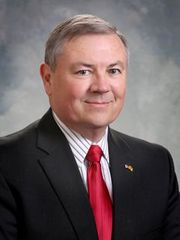Proposal to Study CCS Technology at San Juan Generating Station Rejected by Senate Panel

By Hannah Grover
March 5, 2019 - New Mexico Sen. William Sharer, R-Farmington, said Farmington could become the center of clean coal technology if Acme Equities acquires the San Juan Generating Station and installs carbon capture and sequestration technology on the plant.

William Sharer
Carbon capture and sequestration involves separating carbon dioxide from gases and sending it in compressed form through a pipeline to either be injected into the ground or used to increase oil production.
Sharer today proposed an unsuccessful amendment to the Energy Transition Act that would have given Acme the opportunity to commission an independent 90-day feasibility study. This study would have looked at installing CCS technology on the power plant, which would enable it to remain open past 2022.
The Energy Transition Act passed the Senate Corporations and Transportation Committee today with a "do pass" recommendation and now heads to the Senate floor. While Sharer argued for his amendment, it was not accepted as part of the bill.
Sharer did not support the bill without the amendment.
In addition to requiring the feasibility study, Sharer’s amendment would have required Acme to begin construction in 2023. He explained that Acme would need to begin construction in 2023 to qualify for federal tax credits.
If those benchmarks are not met, Sharer said the San Juan Generating Station will close. However, if the benchmarks are met, he anticipates San Juan Generating Station could be the cleanest power plant in the world.
The CCS technology can reduce 90 percent of carbon dioxide emissions, Sharer said.
“That is far superior to anything else that is going on out there,” Sharer said.
He said renewable sources like solar often require natural gas backup to provide power when the sun isn’t shining. Sharer said CCS would allow San Juan Generating Station to produce less carbon dioxide than a natural gas power plant.
Sharer said no one would notice if a cup of water was taken out of a flood. However, he said installing carbon capture and sequestration technology on the power plant could make Farmington the center of clean coal technology.
Sharer said if it works on the San Juan Generating Station the technology could be installed in power plants worldwide. In his flood scenario, Sharer said that would be equivalent to reducing the flow of water down Main Street.
Sharer’s amendment was backed by local leaders.
“We are only asking for 90 days to see if we can create an extraordinary win-win-win for the real families whose livelihood depends on their job at the coal mine and (San Juan Generating Station), the local and state economies and for the environment,” said Farmington Mayor Nate Duckett in a press release issued before the hearing.
Acme Plans to Sell Captured Carbon Dioxide
Acme plans on sending some of the carbon dioxide captured using the CCS technology to the Permian Basin oil field. Selling this carbon dioxide could offset some of the cost of the technology. Sharer said carbon dioxide is currently being mined for use in the oil fields. He highlighted the Kinder Morgan operation in Cortez, Colorado.
.png)
The pipeline to transport the carbon dioxide from Cortez to the oil fields in the Permian Basin runs about 20 miles from the San Juan Generating Station. Slides Acme gave to legislators that were acquired by the Energy and Policy Institute detail plans to build a 20-mile connector pipeline to the Cortez pipeline.
While Acme hopes to sell the carbon dioxide, other coal-fired power plants that have implemented CCS technology have struggled with those sales.
Two Coal Power Plants Have Had Similar Retrofits
There have only been two large-scale commercial coal-fired power plants retrofitted with CCS technology. These are Unit 3 of Boundary Dam Power Station in Saskatchewan, Canada, and Petra Nova in Texas.
Both power plants sell captured carbon dioxide to oil fields. However, a feasibility report for CCS on the Shand Power Plant, located near Boundary Dam, states that not all the captured carbon dioxide has been sold. The feasibility report was released in November.
According to the feasibility report, the price of oil determines whether an oil company will want carbon dioxide to pump into the ground to force more oil out of wells. When oil companies do use carbon dioxide, they need a reliable supply. Boundary Dam was unable to provide a reliable stream of carbon dioxide because it was prone to interruptions.
Previous CCS Installations Cost at Least $1 Billion
The CCS technology installation on Boundary Dam unit 3 cost about $1.3 billion. Unit 3 generates less than 200 megawatts of electricity while San Juan Generating Station’s units generate 340 megawatts and 507 megawatts of power.
A report presented last year by the Congressional Research Service states $800 million was used to build the CCS technology while $500 million was used to retrofit Boundary Dam unit 3.
Acme estimates retrofitting the San Juan Generating Station will cost between $400 million and $800 million, according to the slides obtained by the Energy and Policy Institute.
The Estevan Mercury reported the total cost of the CCS project at Shand will be similar to Boundary Dam's cost, however Shand produces about twice the power as Boundary Dam produces.
Petra Nova's CCS project cost about $1 billion and was completed in 2017, according to the U.S. Energy Information Association. Petra Nova also uses CCS on a smaller scale than Acme has planned for the San Juan Generating Station.
The Energy and Policy Institute reported that other attempts to install CCS on coal-fired power plants have been abandoned due to costs. In one case, a CCS project in Kemper County, Missouri, was abandoned after it surpassed its $1.5 billion budget and the company invested $7.5 billion into the project. The plant now operates as a combined-cycle natural gas plant.

